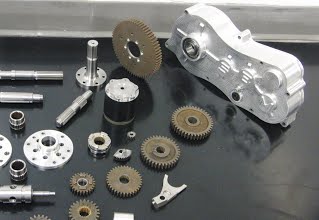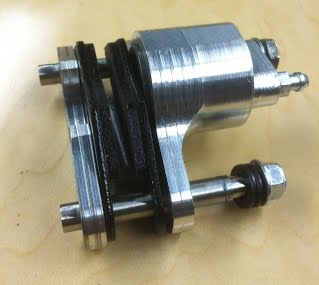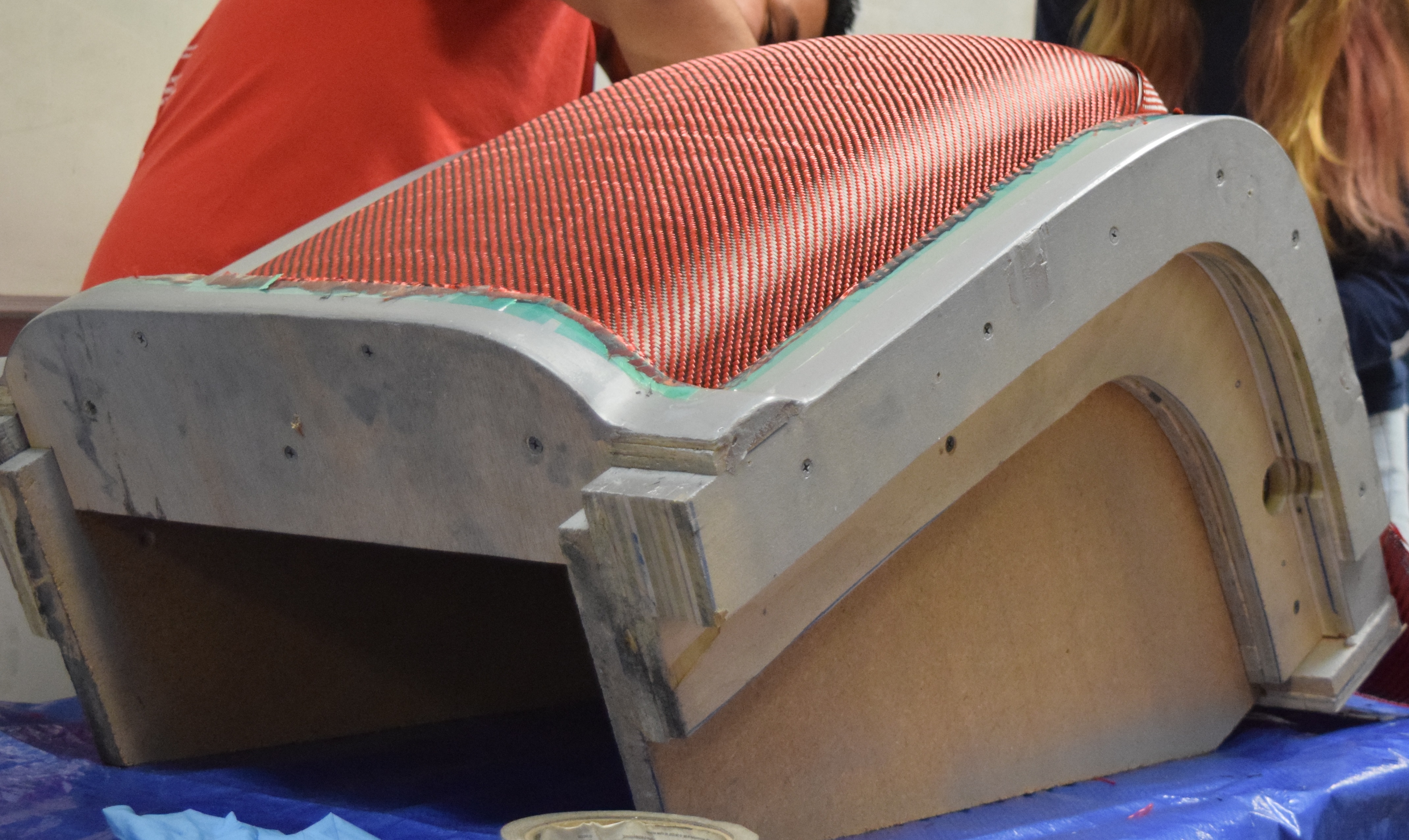Subsystems
As a member of Stony Brook Motorsports, you have a choice to participate in any of seven main subsystems. These include powertrain, chassis, electronics, steering, suspension, control systems, and composites. All of the subsystems are important and dependent on each other. Students typically do not choose just one subsystem to work on, but divide their time where their help is needed most.
Powertrain
 The powertrain subsystem includes a standard, unmodified Briggs & Stratton 10HP engine and everything that is responsible for transmitting its power to the wheels. The first component after the engine is the continuously variable transmission (CVT). The CVT provides a dual purpose in our vehicle. First, it acts as an automatic transmission, allowing adjustment to the final drive ratio; second, it functions as a clutch between the engine and transmission as its pulleys allow for slip at engine idle. After the CVT, power is transferred into a standard transmission, allowing gear ratios in forward and reverse. This is helpful for different parts of the competition or when our motion is hindered by an obstacle. Power is then transmitted to the differential, whose job is to directly power the left and right wheels while allowing them to rotate at different velocities around turns. Out of the differential, power goes to the rear wheels via a set of constant velocity (CV) joints and half shaft axles. Every year, Stony Brook Motorsports designs, fabricates, and tests our own custom gearbox.
The powertrain subsystem includes a standard, unmodified Briggs & Stratton 10HP engine and everything that is responsible for transmitting its power to the wheels. The first component after the engine is the continuously variable transmission (CVT). The CVT provides a dual purpose in our vehicle. First, it acts as an automatic transmission, allowing adjustment to the final drive ratio; second, it functions as a clutch between the engine and transmission as its pulleys allow for slip at engine idle. After the CVT, power is transferred into a standard transmission, allowing gear ratios in forward and reverse. This is helpful for different parts of the competition or when our motion is hindered by an obstacle. Power is then transmitted to the differential, whose job is to directly power the left and right wheels while allowing them to rotate at different velocities around turns. Out of the differential, power goes to the rear wheels via a set of constant velocity (CV) joints and half shaft axles. Every year, Stony Brook Motorsports designs, fabricates, and tests our own custom gearbox.
Chassis
 Every year a tubular frame chassis is designed and fabricated for the Baja vehicle. In the fall semester, the focus is on designing the chassis using 3D modeling software. Real world testing along with stress and torsional stiffness simulations aids the development of the chassis. Members of the chassis subsystem work alongside all the other subsystems to ensure that the strength and geometry of the chassis satisfies the requirements set by the Society of Automotive Engineers (SAE) for the competition, along with the design criteria established by the team. Fabrication of the frame begins during winter break.
Every year a tubular frame chassis is designed and fabricated for the Baja vehicle. In the fall semester, the focus is on designing the chassis using 3D modeling software. Real world testing along with stress and torsional stiffness simulations aids the development of the chassis. Members of the chassis subsystem work alongside all the other subsystems to ensure that the strength and geometry of the chassis satisfies the requirements set by the Society of Automotive Engineers (SAE) for the competition, along with the design criteria established by the team. Fabrication of the frame begins during winter break.
Electronics
 Electronics are implemented in the design, testing, and fabrication of the vehicle in many ways. Data acquisition through an assortment of sensors gives designers useful information about a variety of characteristics, including various angular velocities and accelerations, suspension travel, and component temperatures. This data is then utilized in the design process to create/modify parts or to verify and reinforce computer-simulated results through real-world testing. A driver-interface system has been used in the past to allow the driver to view live information about the vehicle through an LCD mounted in front of the steering wheel. In addition, all of the required lighting, alarms, and kill-switches are covered under this subsystem.
Electronics are implemented in the design, testing, and fabrication of the vehicle in many ways. Data acquisition through an assortment of sensors gives designers useful information about a variety of characteristics, including various angular velocities and accelerations, suspension travel, and component temperatures. This data is then utilized in the design process to create/modify parts or to verify and reinforce computer-simulated results through real-world testing. A driver-interface system has been used in the past to allow the driver to view live information about the vehicle through an LCD mounted in front of the steering wheel. In addition, all of the required lighting, alarms, and kill-switches are covered under this subsystem.
Steering
 The steering subsystem is responsible for providing the operator with maximum directional control over the vehicle via the steering wheel. The steering wheel rotational input is transferred down the steering column to the steering rack. The purpose of the steering rack is to the translate the rotational motion of the steering column into lateral, linear motion by means of a rack and pinion gear set. Attached on each side of the rack are tie rods, which transfer the lateral motion of the rack to the steering arms - one mounted at each front wheel. When the tie rods push / pull on the steering arms, there is a change in the direction of the wheel. The combined ratio of the gear set and steering arms provide the final steering ratio of the vehicle. In the end, if the driver turns the steering wheel clockwise, the car will turn right and when turned counterclockwise, the car will turn left.
The steering subsystem is responsible for providing the operator with maximum directional control over the vehicle via the steering wheel. The steering wheel rotational input is transferred down the steering column to the steering rack. The purpose of the steering rack is to the translate the rotational motion of the steering column into lateral, linear motion by means of a rack and pinion gear set. Attached on each side of the rack are tie rods, which transfer the lateral motion of the rack to the steering arms - one mounted at each front wheel. When the tie rods push / pull on the steering arms, there is a change in the direction of the wheel. The combined ratio of the gear set and steering arms provide the final steering ratio of the vehicle. In the end, if the driver turns the steering wheel clockwise, the car will turn right and when turned counterclockwise, the car will turn left.
Suspension
 Currently the vehicle is designed utilizing a short long arm (SLA) type suspension for the front and a trailing arm suspension for the rear. It is a four wheel independent suspension setup that provides a considerable amount of control over rough terrain. Design of the suspension requires a combination of numerical analysis, computer simulation, and real world testing. All other subsystems are vastly affected by suspension geometry, tire choice, and shock setting. Because nearly all suspension components are fabricated by the team, members will learn about the design, fabrication, data collection, and analysis techniques involved in the performance and handling of the vehicle to a considerable degree.
Currently the vehicle is designed utilizing a short long arm (SLA) type suspension for the front and a trailing arm suspension for the rear. It is a four wheel independent suspension setup that provides a considerable amount of control over rough terrain. Design of the suspension requires a combination of numerical analysis, computer simulation, and real world testing. All other subsystems are vastly affected by suspension geometry, tire choice, and shock setting. Because nearly all suspension components are fabricated by the team, members will learn about the design, fabrication, data collection, and analysis techniques involved in the performance and handling of the vehicle to a considerable degree.
Control Systems
 The control systems of the vehicle encompasses all driver-vehicle interfaces. Cockpit ergonomics are researched to ensure that the car is suitable for a wide demographic (5 percentile female to 95th percentile male). Transmission and steering controls are laid out to ensure that the driver can quickly and comfortably control the vehicle without excessive effort. This group is also tasked with designing the brake system so that the car successfully locks all four wheels, a requirement for technical inspection. Any electronics on the vehicle are also included in the control systems category (Data Acquisition Systems).
The control systems of the vehicle encompasses all driver-vehicle interfaces. Cockpit ergonomics are researched to ensure that the car is suitable for a wide demographic (5 percentile female to 95th percentile male). Transmission and steering controls are laid out to ensure that the driver can quickly and comfortably control the vehicle without excessive effort. This group is also tasked with designing the brake system so that the car successfully locks all four wheels, a requirement for technical inspection. Any electronics on the vehicle are also included in the control systems category (Data Acquisition Systems).
Composites
 To minimize weight on the vehicle, ABS plastic panels are thermoformed using handmade and machined wooden molds.The 1/16” ABS plastic sheets are easy to form and create light weight panels that protect the driver and vehicle components from debris. The seat, CVT cover, and light panel are made of carbon fiber to maintain a low weight, yet provide high strength and rigidity. The molds are carefully waxed and prepared with a release agent to ensure that the epoxy resin does not bond with the mold. After the carbon fiber is laid down, epoxy resin is applied and the piece is vacuumed bagged to remove any excess epoxy resin.
To minimize weight on the vehicle, ABS plastic panels are thermoformed using handmade and machined wooden molds.The 1/16” ABS plastic sheets are easy to form and create light weight panels that protect the driver and vehicle components from debris. The seat, CVT cover, and light panel are made of carbon fiber to maintain a low weight, yet provide high strength and rigidity. The molds are carefully waxed and prepared with a release agent to ensure that the epoxy resin does not bond with the mold. After the carbon fiber is laid down, epoxy resin is applied and the piece is vacuumed bagged to remove any excess epoxy resin.